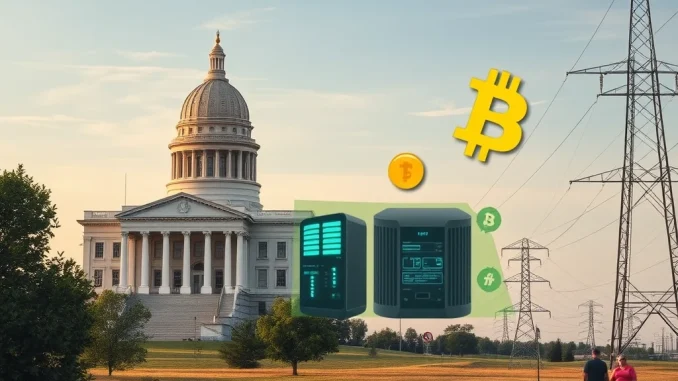
The landscape for large-scale crypto mining operations is evolving, and Nebraska is the latest state to introduce significant regulations. If you’re involved in or follow the crypto mining industry, particularly in the U.S., this development from the Cornhusker State is worth paying attention to.
What Does Nebraska’s Crypto Mining Regulation (LB 526) Mean?
The Nebraska Legislature recently passed LB 526, a bill specifically targeting large-scale crypto mining operations. This legislation, which takes effect in 2025, introduces new requirements and oversight, primarily centered around energy consumption and infrastructure.
According to reports, the core of LB 526 grants significant authority to public power suppliers over miners using one megawatt (MW) or more of electricity. This threshold clearly targets industrial-scale operations rather than small home setups.
Key Requirements for Large-Scale Mining Operations
The bill outlines several mandates for these larger mining facilities. Understanding these points is crucial for anyone operating or planning to operate in Nebraska:
- Infrastructure Upgrade Costs: Miners using 1 MW or more are now required to cover the costs associated with necessary infrastructure upgrades needed to support their high energy usage.
- Load Studies: The law mandates that these operations undergo load studies to assess their impact on the local power grid.
- Public Reporting: Transparency is key. LB 526 requires public reporting of energy usage by large-scale miners. This allows utilities and the public to understand the power demands of these facilities.
- Service Interruption: Utilities are granted the ability to interrupt service to mining operations under standard rate policies. This suggests that miners may face service disruptions during periods of high demand or grid stress, similar to other large industrial users.
These measures aim to address concerns about the strain that intensive crypto mining can place on local power grids and infrastructure, ensuring that the costs and impacts are properly managed and accounted for.
Addressing Energy Usage Concerns
One of the most debated aspects of large-scale mining is its substantial energy usage. Nebraska’s approach through LB 526 directly confronts this by:
- Making miners financially responsible for grid impacts.
- Increasing transparency around consumption.
- Allowing utilities flexibility to manage demand.
This regulation reflects a growing trend among states and jurisdictions to grapple with the energy footprint of the crypto industry, particularly large-scale mining facilities that can consume significant amounts of power, sometimes impacting local energy prices and availability.
What’s Next for Nebraska Crypto Mining?
With LB 526 set to take effect in 2025, large-scale mining operators in Nebraska will need to adjust their business models and operations to comply with the new requirements. This includes budgeting for potential infrastructure costs, participating in load studies, and setting up systems for public energy reporting.
The bill’s passage signals a proactive stance by Nebraska regulators to integrate high-demand industrial activities like large-scale mining into existing energy frameworks while protecting public power resources. It sets a precedent for how states can approach the unique energy demands of the crypto industry.
In Summary
Nebraska’s LB 526 represents a significant step in crypto mining regulation at the state level. By requiring large-scale miners to bear infrastructure costs, report energy usage, and comply with utility service policies, the state aims to ensure the industry operates responsibly within its power grid capabilities. This move highlights the ongoing dialogue between the energy sector and the evolving world of cryptocurrency mining.



